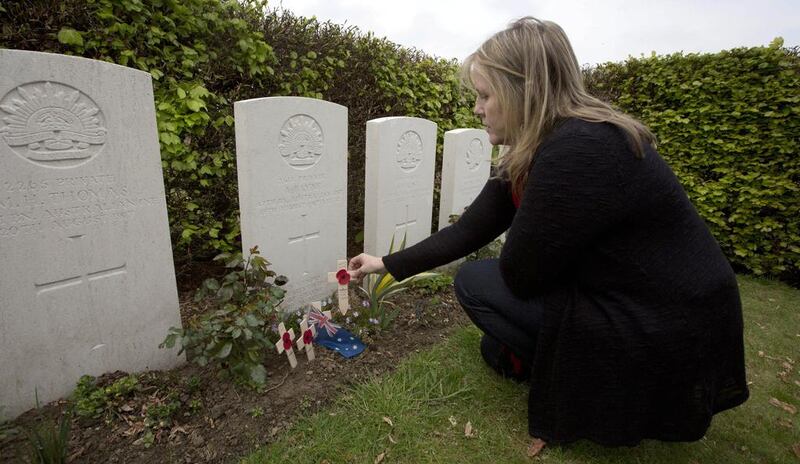NIEUWKERKE, Belgium // In a neatly clipped corner of the Westhof Farm Cemetery, an Australian family huddled around Private Andrew Bayne’s grave. One century after the start of the First World War, the family paid homage to a forebear who had travelled half the world to meet his death, his stomach ripped open by an exploding shell, in the horrors of Flanders Fields.
Bayne left his wife, Katie, with four young children in Brisbane and a prescient letter of regret: “What a dammed fool I was to ever have enlisted.”
Bayne lies alongside other Commonwealth victims and a handful of German dead, the rows of pristine white tombstones stretching over rich, undulating pastures. Belgium and France are still scarred by more than 1,000 graveyards, countless bomb craters, rusting gas shells, bunkers and trenches that tore apart the Western Front for four years.
The front line of death and destruction burnt through the Alps, Central Europe and beyond. It claimed some 14 million lives – 5 million civilians and 9 million soldiers, sailors and airmen from 28 countries.
The conflict that spanned from 1914 to 1918 was so unprecedented in its scope and savagery that it became known simply as “The Great War”. At least 7 million troops were left permanently disabled and families across the globe, much like Bayne’s, were wrecked.
Despite the vows of “never again” across a shell-shocked world, the outcome of the conflict only sowed the bitter seeds that led to the Second World War and more slaughter. And the nationalist tensions that set off the killing never really died, most recently resurfacing in Ukraine and Russia.
For Kaylene Biggs, misty-eyed after finally facing the grave of her great-grandfather, the war’s far-reaching legacy makes remembrance all the more important. “It isn’t until you do visit the battlefields that you realise the huge amount of loss and sacrifice.”
“Now, it seems so peaceful,” she said amid the twitter of birds and the faraway galloping of a horse.
The early summer of 1914 seemed just as tranquil to most Europeans. By that time, the Bayne family had already been in Australia for two years, hoping to build a richer life after toiling for meagre rewards on a Scottish farm.
Little did they know that Europe wouldn’t let them go so easily.
Both sides had initially expected a quick war, but it soon became a deadly stalemate the likes of which had never been seen.
Sometimes tens of thousands would die in a single day. Artillery was relentless. Toxic gas was introduced in modern warfare with devastating effect. Because of it, the need for fresh manpower was enormous – and the reach of the British Empire was global.
It was only a matter of time for the war to turn up at Andrew Bayne’s doorstep in Brisbane.
Bayne was hardly gung-ho about the war. What turned things around, Ms Biggs said, was that “one day in the street, he was handed a white feather”, at the time a universal sign for cowardice.
“So he went and joined up.”
He enlisted in June 1916, left Australia four months later – and arrived in France from England in March of the following year, just one indication of the pace of war a century ago.
Family archives showed Bayne fought at Bullecourt in northern France, where two battles cost Australia 10,000 casualties and hardly moved the front line.
Bayne, like so many millions of soldiers, long remained hopeful as the war stretched into its fourth year. The Germans, he wrote home, “are about starved out and they can’t last much longer”.
He added: “Cheer up. I will be with you yet.”
On August 19, 1917, a German shell burst close to him as he was on the Ypres front holding the line close to Messines Ridge, little more than a molehill but a killer of thousands on both sides.
The pain and agony were recorded matter-of-factly in a witness report: “The wounds were left arm, right of face and stomach – the latter a bad one.”
Bayne could still call for a stretcher and, before losing consciousness, utter: “They have got me.”
He died soon afterward at age 32.
Like the hundreds of thousands expected to come to Europe from across the world over the next four years, the Baynes’ pilgrimage has been multi-generational.
Ms Biggs and her husband, Peter, also brought their three children.
“His children and his wife weren’t able to come,” said Kaylene’s daughter Jaleesa, 18. “They, in a sense, didn’t get closure but we are able to come here and able to see what they always wanted to see.”
For Ms Biggs and her family, a trip across the globe to a simple grave in a small cemetery has meant the world.
“With all this sadness, I am so thankful that he actually does have a grave, somewhere for his descendants to go to pay their respects,” she said.
“I feel comforted that his sacrifice has not been forgotten through time.”
* Associated Press





